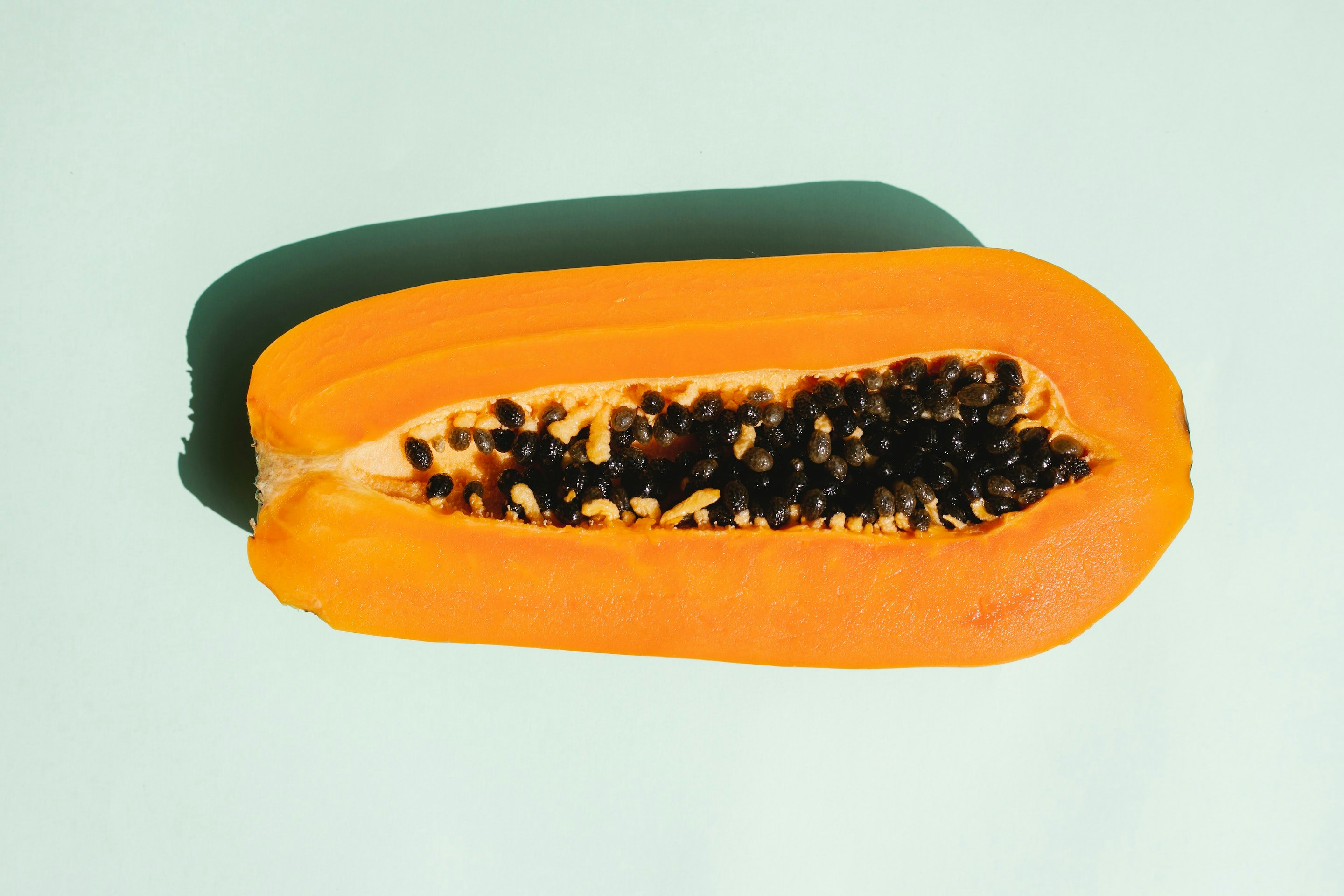Papaya is a yummy tropical fruit from Central America. It has a deliciously sweet and musky taste and is usually eaten raw. This juicy fruit is big and oval-shaped, and its flesh can be yellow, orange, or red. When you cut it open, you'll find a bunch of tiny, round, black seeds inside that you can eat once they're ripe.
Buying papayas can be a real pain sometimes. You think you've found the perfect one, only to discover it's either unripe or way too ripe. It's frustrating, right? Those deceivingly plump papayas can really throw you off. And once you cut into them, there's no turning back. They either won't ripen or they'll rot quickly.
And let's not even get started on the overripe ones. Mushy texture and a stinky smell, which brings me to the fact that many people find papayas off putting.
But don't worry, your days of papaya struggles are over. Here's a quick tutorial to help you figure out if a papaya is actually ripe or not.
How to Pick a Ripe Papaya
When you're picking out a ripe papaya, there are a couple of important things to keep in mind. Remember that papayas are usually harvested when they're still green, and they continue to ripen over time. That means the ones you see in the store could be at any stage of ripeness.
Here's how you can tell if a papaya is ripe and ready to eat:
- Color: When a papaya is ripe, it usually has a yellow skin, like a ripe papaya ready for eating. If it's yellow-orange, it's heading towards being overripe but can still be eaten. Keep in mind, the color can vary depending on the type of papaya. An orange papaya is most likely overripe.
- Skin texture: Gently press your fingers against the papaya's skin. A ripe papaya should feel slightly soft and yield to pressure. While the texture won't tell you if it's ripe, it can indicate if it's spoiled.
Avoid papayas with black or moldy finger-sized depressions, black spots, sunken spots, white specs, cuts, or bruises. Small blemishes are generally fine, but excessive damage may suggest spoilage or improper handling. - Look for mold: Papayas are notorious for attracting mold. Since they're like giant water and sugar tanks without a hard shell like melons, molds find them ideal for growth.
- Smell: Give it a sniff near the stem. A ripe papaya will have a sweet and fragrant aroma. If it doesn't smell much, it might not be fully ripe.
- Weight: Pick up the papaya and feel its weight. Ripe papayas are usually heavier because they have more water. If it feels too light, it might not be ripe yet.
- Check the stem end: Look at the top of the papaya. A ripe one will have a slightly soft or sunken stem end. The stem end should also be yellow. If it's hard or green, the papaya might not be fully ripe.
If you're not going to eat the papaya right away, we suggest getting a green-yellow papaya and letting it ripen at home. Keep in mind that papayas can continue to ripen after you buy them, so if you come across one that's slightly underripe but looks good, you can leave it at room temperature for a few days until it's fully ripe. Once it's ripe, you can store it in the fridge to keep it fresh for longer.
How to Ripen a Papaya
If you're in a hurry to use your papaya or simply can't wait for it to ripen in the fruit bowl, there's a quick and easy method to ripen it. Just grab a paper bag and place your papaya inside, folding or rolling it closed. Within two to three days, your fruit will be perfectly ripe and ready to eat. For an extra boost, you can toss in an apple or ripe banana to speed up the process even more. They produce a gas called ethylene that helps ripen the papaya faster. So go ahead and satisfy that papaya craving in no time.
How to Slow Down the Ripening Process
Alright, so you've got a nice, juicy papaya, but what if you're not quite ready to dig in? No worries! Just pop that ripe papaya in the fridge until you're ready to enjoy it. This will help prevent it from going bad. You can keep the papaya in the fridge for up to a week, but for the best taste, try to use it within two days.
How To Store Papayas
You can keep whole papayas on your kitchen counter or in a fruit bowl at room temperature. They will stay fresh for about a week. If you prefer, you can store them in the refrigerator, where they can last up to three weeks. Putting them in the fridge slows down the ripening process. Just make sure to check on them regularly to make sure they haven't become too soft, which means they're overripe. When you cut into a papaya, cover it with cling wrap to prevent its smell from affecting other food and to keep its flavor intact.
How to Freeze Papaya
Alright, so here's what you gotta do: chop up the papaya flesh into 1-inch cubes and spread them out on a baking sheet, making sure they're not touching. Pop that tray in the freezer and let it chill overnight or until they’re all frozen solid. Once that's done, just transfer the frozen cubes into a plastic bag or container that you can seal up real tight. And voilà! Your papaya will stay good in the freezer for a whole year.
Love Them or Hate Them
Papaya has this unique and powerful aroma that can be a turn-off for some folks. It's kind of like Marmite – you either adore it or detest it. This is all thanks to an enzyme called papain, which gives the fruit its strong and earthy scent. People who aren't fans of papaya can't stand its taste and texture, while papaya enthusiasts appreciate it for those exact reasons.
Male and Female Papaya Trees
The papaya tree, scientifically known as Carica papaya, has a slim trunk with leaves that are deeply lobed and create an umbrella-like shape on top. The female trees bear fruit, which can be found just below the leafy canopy. On the other hand, the male trees only produce flowers.
When it comes to harvesting, papaya producers typically prefer to pick the unripened fruit to avoid any damage caused by excessive handling. Unlike melons, papayas ripen even after they have been harvested. So, there you have it, the papaya tree and its unique characteristics.
Are Papayas Healthy?
Papaya is high in antioxidants, vitamins A and C, and is a good fiber source. It’s eaten as a snack, and often used in salads. Papaya juice and smoothies are to die for.
Origins of Papayas
The papaya has its roots in the tropical regions of the Americas, specifically in Mesoamerica (think Mexico and Central America). People have been growing and using this fruit for thousands of years.
We don't know exactly where the papaya originated from, since it has been cultivated and spread across different regions for centuries. It's believed that indigenous cultures in Mexico and Central America first started growing and selecting wild papaya plants for their desirable traits.
Over time, papaya cultivation made its way to other parts of the Americas, like the Caribbean islands and South America, thanks to trade and people moving around. And during the 16th century, Spanish explorers played a big part in bringing papaya to other parts of the world.
Today, papayas are grown and enjoyed in many tropical and subtropical areas worldwide. Apart from the Americas, important countries for papaya production are Mexico, Brazil, India, Thailand, Indonesia, Nigeria, and the Philippines.
The natural versatility and ability to adapt of papayas have resulted in the creation of different types and strains with unique features in terms of size, shape, color, and taste. These differences have emerged through both natural and human selection over many generations of farming.
Papaya Production in the United States
Papayas are a yummy tropical fruit that thrives in warm and humid conditions. In the United States, they're mainly grown in Hawaii and southern Florida.
Like pineapples, Hawaii's perfect climate and volcanic soil make it the ideal place to grow papayas. They have two main varieties: the Solo (also called Strawberry papaya) which is small to medium-sized, and the Hawaiian Sunrise papaya which is bigger and sweeter than the Solo. Both varieties have yellow skin when ripe and vibrant orange or pinkish flesh.
In southern Florida, especially in places like Miami-Dade and Broward counties, papayas are grown on a smaller scale. The subtropical climate there is just right for growing papayas. They mainly grow Mexican papaya varieties like Maradol and Red Lady.
Are Papayas Seasonal?
Papayas are usually available all year round since they are grown in different regions with varying growing seasons. However, the specific availability and peak seasons of papayas can differ depending on where you are.
In certain areas, papayas may have a specific time of the year when they are more abundant. For instance, in some parts of North America, like Hawaii, papayas are generally at their peak from late spring to early fall.
On the other hand, Mexican papayas have a longer growing season and may be available throughout the year in certain regions.
To ensure you get the freshest and most flavorful papayas, it's a good idea to check with your local farmers' market or grocery store to find out when they are in season in your area.
Conclusion
In conclusion, picking a ripe papaya can be a daunting task for many individuals. However, by following the tips outlined in this article, you can confidently select a delicious and sweet papaya every time. Remember to look for signs of ripeness such as a yellow to orange skin color, softness when gently pressed, and a sweet aroma. By incorporating these tips into your papaya selection process, you can enjoy this tropical fruit at its best. Happy papaya picking!



Comment